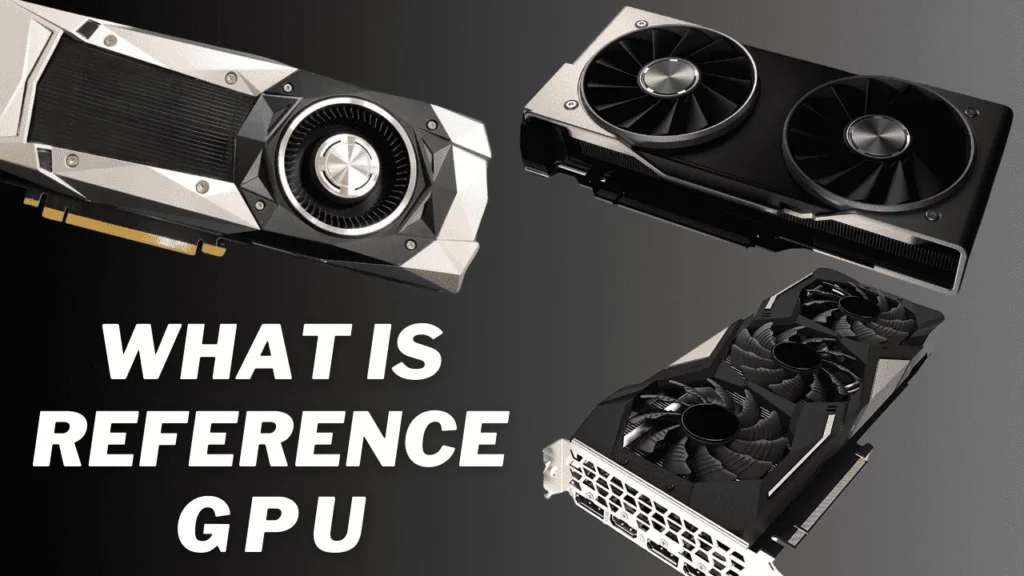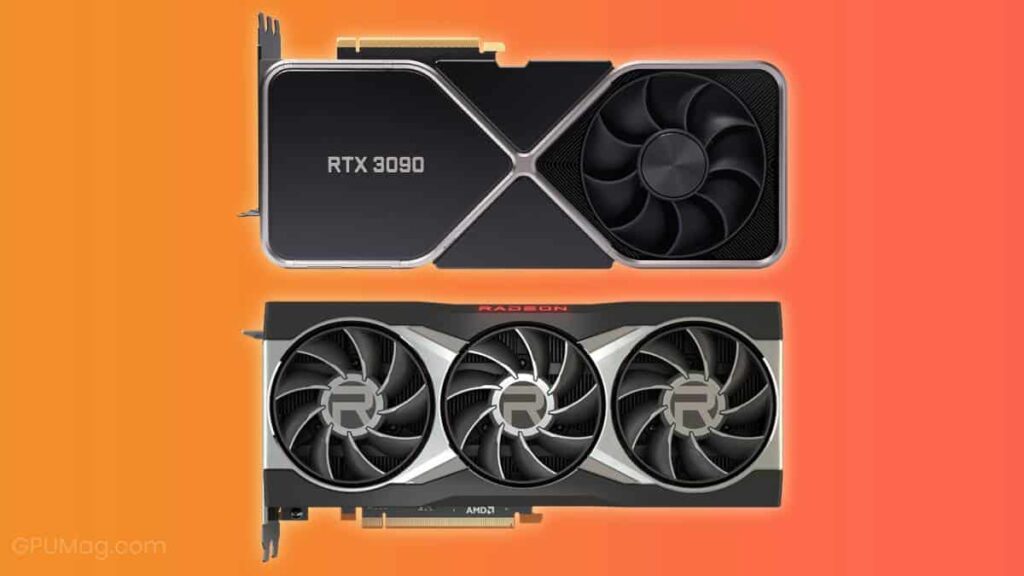Table of Contents
A reference GPU is the original design from manufacturers like NVIDIA or AMD, offering a sleek build and reliable cooling. When I first tried one, it felt great for early access, though custom GPUs later impressed me with quieter performance.
What Is A Reference GPU? It is the original graphics card design by NVIDIA or AMD. It offers a simple design and reliable cooling for early buyers.
Stay tuned with us as we dive into the topic of “What Is A Reference GPU” and explore its design, benefits, and why it might be the right choice for you.
What Is a Reference GPU?

A reference GPU is the original version of a graphics card designed directly by GPU manufacturers like NVIDIA or AMD. It serves as the baseline model, showcasing standard performance, cooling, and design, and acts as the foundation for custom versions made by third-party manufacturers.
Graphics cards are essential components of any gaming or high-performance PC, and understanding reference GPUs can help you make an informed buying decision. In this guide, we’ll explore everything you need to know about reference GPUs, including their characteristics, advantages, and disadvantages.
Characteristics of a Reference GPU
A reference GPU comes with distinct features that differentiate it from custom or non-reference models:
Standard Design:
Reference GPUs follow a fixed design set by the manufacturer. This design serves as a template for third-party manufacturers to create their own versions with enhanced features.
- Uniform Build: Reference GPUs feature a straightforward, minimalistic design without flashy elements like RGB lighting or fancy cooling shrouds.
- Compact Size: These cards often fit easily into smaller PC cases, making them versatile for different build setups.
Baseline Performance:
Manufacturers like NVIDIA and AMD release reference GPUs with stock clock speeds and specifications that represent the “default” performance of the card.
- These GPUs are not factory overclocked, so their performance is predictable and consistent.
- Perfect for benchmarking and setting industry standards.
Blower-Style Cooling:
Most reference GPUs feature blower-style cooling systems. This design expels hot air directly out of the case, which is ideal for small or compact PC builds but less effective for extreme overclocking.
First-to-Market Availability:
Reference GPUs are typically the first versions released when a new GPU generation launches, giving enthusiasts early access to cutting-edge technology.
Standard PCB Design:
The printed circuit board (PCB) design of reference GPUs is standardized, ensuring compatibility with aftermarket cooling solutions, such as water blocks or custom air coolers.
Read More: How to Determine the Right Direction for Your GPU Fan – A Comprehensive Guide!
Why Do Reference GPUs Exist?
Setting a Baseline for Performance:
Reference GPUs establish a benchmark that third-party manufacturers use to develop their custom cards. This helps ensure consistent performance metrics across the industry.
Showcasing New Technology:
Manufacturers like NVIDIA and AMD use reference GPUs to demonstrate the capabilities of their latest architectures, such as improvements in ray tracing, power efficiency, or artificial intelligence-based features.
Compatibility and Standardization:
With a uniform design, reference GPUs guarantee compatibility with:
- Motherboards
- PC cases
- Aftermarket cooling solutions
This standardization reduces potential compatibility issues for users.
Easier Benchmarking:
Reviewers and tech enthusiasts rely on reference GPUs to provide unbiased performance reviews of new GPU architectures. This ensures consistency when comparing different models.
Advantages of Reference GPUs:

Reference GPUs offer several benefits, especially for certain types of users:
Early Access to New Technology:
These cards are usually available at launch, allowing enthusiasts to experience the latest advancements before custom models hit the market.
Predictable Performance:
The stock settings of reference GPUs ensure reliable and consistent performance, making them ideal for users who prioritize stability.
Compact Cooling Design:
Blower-style coolers are smaller and exhaust heat directly out of the case, which is helpful for small form-factor (SFF) builds.
Aftermarket Modding Potential:
The standard PCB layout of reference GPUs makes them compatible with water cooling blocks and other aftermarket solutions. This makes them a good choice for custom water-cooled PC builds.
Resale Value:
Reference GPUs often retain their value better than some custom cards due to their early availability and simplicity. They are typically favored by collectors and enthusiasts for their clean design. Additionally, their widespread compatibility makes them a safer choice for buyers in the second-hand market.
Disadvantages of Reference GPUs
Despite their benefits, reference GPUs have some downsides:
Limited Cooling Efficiency:
Blower-style cooling systems are less effective at managing heat than multi-fan designs or liquid cooling solutions found in custom GPUs. This can lead to higher operating temperatures.
Restricted Overclocking Potential:
Reference GPUs are not designed for aggressive overclocking, as their cooling and power delivery systems are more limited compared to custom models.
Higher Noise Levels:
The blower-style fan in reference GPUs tends to produce more noise under heavy load than the quiet, multi-fan setups used in custom cards.
Premium Price for Founder’s Edition Models:
In some cases, like NVIDIA’s Founder’s Edition GPUs, reference cards can be priced higher than custom models, despite offering fewer features.
Founder’s Edition GPUs vs. Reference GPUs:
A Founder’s Edition GPU is NVIDIA’s branding for its reference cards. While similar to traditional reference GPUs, they often come with slight enhancements:
- Premium Cooling: Founder’s Edition cards sometimes feature upgraded cooling systems compared to standard reference GPUs.
- Exclusive Availability: These cards are often limited edition and sold directly by NVIDIA.
- Higher Price: Founder’s Edition GPUs usually have a higher price tag compared to other reference or custom cards.
AMD’s reference GPUs, by contrast, stick to a more traditional design without additional branding or premium features.
Read More: Do Gpu brand matter – Simple Guide 2024!
Reference GPUs vs. Custom GPUs:
Custom GPUs, created by third-party manufacturers like MSI, ASUS, or Gigabyte, are built upon reference designs but come with additional features. Here’s a detailed comparison:
| Feature | Reference GPU | Custom GPU |
| Cooling System | Blower-style cooler | Multi-fan or liquid cooling |
| ClockSpeeds | Stock speeds | Factory-overclockd |
| Aesthetics | Simple design | RGB lighting, custom shrouds |
| Price | Generally lower | Can be higher |
| Noise Levels | Higher noise | Quieter operation |
| Overclocking | Limited potential | Enhanced capabilities |
For users seeking high performance and better cooling, custom GPUs are often a better choice. However, reference GPUs remain a solid option for those who prioritize standardization and early access.
How to Tell If a GPU Is a Reference Model?

Here are a few tips to identify reference GPUs:
- Manufacturer Branding: Look for direct branding from NVIDIA or AMD, such as NVIDIA’s Founder’s Edition.
- Blower-Style Cooler: Reference GPUs often have a single blower fan design.
- Availability Timing: If it’s released alongside a new GPU architecture launch, it’s likely a reference model.
- Standard PCB Design: Reference GPUs lack the extended cooling or customized PCB layouts seen in custom cards.
Should You Buy a Reference GPU in 2024?
The decision depends on your specific needs:
Buy a Reference GPU If:
- You want early access to the latest GPU technology.
- You have a small PC case that benefits from compact cooling solutions.
- You plan to use aftermarket cooling solutions, such as water blocks.
- You value predictable and reliable performance without overclocking.
Avoid a Reference GPU If:
- You need better cooling and quieter operation.
- You’re looking for higher overclocking potential.
- You prefer aesthetic upgrades, like RGB lighting or custom design
Frequently Asked Questions:
1. What is the difference between a reference GPU and a custom GPU?
A reference GPU is the original model designed by manufacturers like NVIDIA or AMD, with a standard cooling system and stock clock speeds. Custom GPUs, on the other hand, are made by third-party manufacturers (e.g., ASUS, MSI) and often come with enhanced features such as improved cooling solutions, higher clock speeds, and unique designs.
2. Is a reference GPU good for gaming?
Yes, a reference GPU is good for gaming, especially if you’re not looking for overclocking or advanced cooling features. It provides solid performance at standard clock speeds and is often ideal for users who prioritize reliability and compatibility over extra features.
3. Are reference GPUs better for overclocking?
No, reference GPUs are not designed for aggressive overclocking. They typically have basic cooling systems (like blower-style coolers) that limit the ability to push the card to higher performance levels compared to custom GPUs, which often feature enhanced cooling and power delivery systems.
4. Why do reference GPUs retain their value?
Reference GPUs tend to retain their value because they are the first models released when new GPU architectures are launched, making them valuable to collectors and enthusiasts. Their simple design and standardization also ensure broad compatibility with aftermarket solutions, further increasing their resale potential.
5. What is a Founder’s Edition GPU?
A Founder’s Edition GPU is NVIDIA’s version of a reference GPU. It often features minor enhancements such as upgraded cooling or a more premium design but still follows the basic reference model’s specifications. These cards are sold directly by NVIDIA and are often limited edition with a higher price tag.
6. Should I buy a reference GPU in 2024?
If you are looking for early access to new GPU technology, have a small PC case, or prefer a simple, reliable design without the need for overclocking or flashy aesthetics, a reference GPU can be a great option. However, if you prioritize better cooling, quieter performance, or custom designs, a custom GPU might be a better choice.
7. Are reference GPUs louder than custom GPUs?
Yes, reference GPUs with blower-style coolers tend to be louder compared to custom GPUs, which often use multi-fan cooling systems that provide quieter operation.
8. What is the typical price of a reference GPU?
Reference GPUs are generally priced lower than custom GPUs, although the price can increase for special editions like NVIDIA’s Founder’s Edition. Prices for standard reference models are often more affordable due to their basic design and lack of advanced features.
9. Can reference GPUs be used for high-performance tasks like 4K gaming?
Yes, reference GPUs can handle 4K gaming, but their performance will be limited by stock clock speeds and less effective cooling systems compared to custom GPUs. For extreme tasks or higher frame rates, custom GPUs with better cooling and higher overclocking potential would be preferable.
10. How can I tell if a GPU is a reference model?
You can tell a GPU is a reference model if it has branding from NVIDIA or AMD (e.g., NVIDIA’s Founder’s Edition), a blower-style cooling system, and a standard PCB design. Additionally, if the card is released alongside the launch of a new GPU architecture, it is likely a reference model.
Conclusion:
A reference GPU is the original design created by NVIDIA or AMD. It offers reliable performance and cooling, making it a solid choice for early adopters. These GPUs are often more affordable and easier to find than custom models. They also retain their value well due to their simplicity and standard design. However, they may not be the best choice for overclocking or high-performance tasks.
Ultimately, a reference GPU is great for those who want a straightforward, reliable option without the extra features of custom models.
